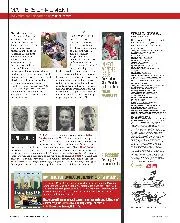
Contributors
Hooked on racing since Stirling’s Aintree win, Mike Doodson has been Team Lotus press officer and part of the BBC F1 commentary team, while earning renown as a racing journalist.…
THE LATEST SPORTS BUGATTI BLOWN AND UNBLOWN MODELS TESTED AT THE MOLSHEIM FACTORY (The First part of this article was published in the May issue)
Forward visibility was good in spite of a steeply raked windscreen, but the body pillars were rather thick and obstructed the driver’s view somewhat on right-hand corners. This and the window-winding handle which caught the coat-sleeve are points being dealt with on later bodies. The front seats were made of metal tubing with padded leather upholstery over a hammock of small spiral springs, forming a resilient but firm seat.
Leg room is rather limited in the rear seats, and a tall passenger finds his knees in close proximity to the front seats when these are set well back. This is the result of having the back seats well forward of the back axle, which in compensation gives better riding and a large luggage boot with the minimum of overhang.
With deep foot-wells and well-padded upholstery the hack passengers can make the most of the room available in the close-coupled coachwork. Returning to the works with Monsieur Bugatti after this highly entertainin test run, we fell to discussing the other models in the Bugatti range. ” The 57s, as you know, have a high compression and a short wheelbase and is practically a racing-car. We only recommend it to clients who are constantly making long fast journeys on open roads, where the car has a chance to warm up properly and to give its full power. All the same we do find a demand for a car which will give an even livelier response from low speeds and a higher maximum than the standard ‘ 57 ‘. That is why we have produced the 57c, which has a Rootstype supercharger driven at engine speed. This puts up the power from 130 to about 160 h.p., and gives a really brilliant acceleration from low engine speeds and of course a higher maximum. The gear-ratios, compression-ratio and chassis are the same, though we can run
up to about 5,300 r,p.m., and the car runs perfectly on. 1.:sso or other ethylised fuels.”
Unfortunately, when we returned there was another disappointment, for the ” blown ” demonstrator had not returned from its run, so with apologies it was suggested that we should go out with one of the testers in a car which had been returned for some adjustment, though we must not take it as representing the full performance of the 57c.
This car again was fitted with a close coupled saloon body and while mechanics were checking over the engine, a routine which included blowing Out a mass of flies from the radiator, we had a chance of admiring the neat installation of the supercharger, which is lubricated from the engine and driven by shaft from the timing gear, which in all the Model 57 series is at the rear of the engine.
All was soon ready, and the tester lost no time in showing the effect of the supercharger in getting acceleration from low speeds. As soon as conditions permitted we swung up from 10 m.p.h. to 85 in an incredibly short time, 211 secs. on one occasion when we were able to time the performance on a level road. The supercharger, which was just audible as a faint rustling at 20 m.p.h., was unnoticed at higher speeds. The engine was a fraction less smooth than that of the unsupercharged car, though this may have been due to its not being in perfect tune in its new owner’s hands. The exhaust note was again rather more virile than that of the unblown car, but still decidedly quiet for a car of such high performance. We timed the car at 105 m.p.h. over a kilometre, so the owner had little to complain about as far as we could see.. (Continued on page 186).
Not being a works car we were unable to test the supercharged model as thoroughly as had been the case with the tinblown car. All the same we found that it ran as effortlessly at 90 m.p.h. as the standard model did at 75 to 80. At the other end of the range it would trickle along at little over walking pace and picked up with enthusiasm from 10 m.p.h. on top. Bottom gear is normally not used, but getting away in second and using the gears, something like racing-car performance is available. Used virtually as a means of improving the distribution and blowing at a maximum pressure of two or three pounds, the supercharger
is shown as a definite asset in the case of a robust engine like that of the 8.3-litre, and gives a fascinating increase in performance without shortening the life or reliability of the car.
Space does not allow of a detailed description of the chassis, but one cannot conclude without remarking on the beautiful finish of the cylinder block and other under-bonnet components, the polished and plated front axle with its integral spring housings, the finned rear axle casing with its array of fastening bolts, the deeply ribbed brake drums, and of the internals, the balanced six-bearing crankshaft turned from a solid billet. No driver with any claims to discrimination can fail to sense the feeling Of safety and response which characterises the two new Type 57 models, and which is the result of racing experience allied
to pride of workmanship. The supercharged car is doubly interesting as representing the logical application of this principle to the fast road car, while the “57 Tourisme,” as the unblown car is modestly called, is fast and lively enough for nine people out of ten and incidentally offers thoroughly good value with the franc at its present low level.